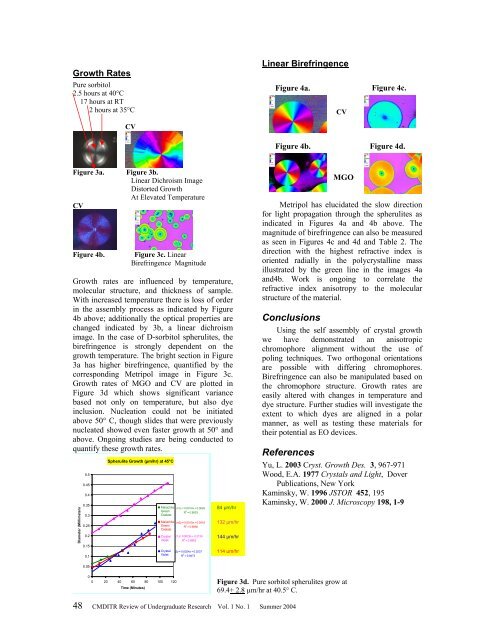CMDITR Review of Undergraduate Research - Pluto - University of ...
CMDITR Review of Undergraduate Research - Pluto - University of ...
CMDITR Review of Undergraduate Research - Pluto - University of ...
Create successful ePaper yourself
Turn your PDF publications into a flip-book with our unique Google optimized e-Paper software.
Growth Rates<br />
Pure sorbitol<br />
2.5 hours at 40°C<br />
17 hours at RT<br />
2 hours at 35°C<br />
Linear Birefringence<br />
Figure 4a. Figure 4c.<br />
CV<br />
CV<br />
Figure 4b. Figure 4d.<br />
Figure 3a. Figure 3b.<br />
Linear Dichroism Image<br />
Distorted Growth<br />
At Elevated Temperature<br />
CV<br />
Figure 4b.<br />
Diameter (Millimeters<br />
0.5<br />
0.45<br />
0.4<br />
0.35<br />
0.3<br />
0.25<br />
0.2<br />
0.15<br />
0.1<br />
Figure 3c. Linear<br />
Birefringence Magnitude<br />
Growth rates are influenced by temperature,<br />
molecular structure, and thickness <strong>of</strong> sample.<br />
With increased temperature there is loss <strong>of</strong> order<br />
in the assembly process as indicated by Figure<br />
4b above; additionally the optical properties are<br />
changed indicated by 3b, a linear dichroism<br />
image. In the case <strong>of</strong> D-sorbitol spherulites, the<br />
birefringence is strongly dependent on the<br />
growth temperature. The bright section in Figure<br />
3a has higher birefringence, quantified by the<br />
corresponding Metripol image in Figure 3c.<br />
Growth rates <strong>of</strong> MGO and CV are plotted in<br />
Figure 3d which shows significant variance<br />
based not only on temperature, but also dye<br />
inclusion. Nucleation could not be initiated<br />
above 50° C, though slides that were previously<br />
nucleated showed even faster growth at 50° and<br />
above. Ongoing studies are being conducted to<br />
quantify these growth rates.<br />
Spherulite Growth (µm/hr) at 45°C<br />
Malachite<br />
Green<br />
Oxalate<br />
Malachite<br />
Green<br />
Oxalate<br />
Crystal<br />
Violet<br />
Crystal<br />
Violet<br />
m1y = 0.0014x + 0.0629<br />
R 2 = 0.9603<br />
m2y = 0.0019x + 0.0418<br />
R 2 = 0.9956<br />
c1y= 0.0022x + 0.2124<br />
R 2 = 0.9962<br />
c2y = 0.0024x + 0.0237<br />
R 2 = 0.9473<br />
84 µm/hr<br />
132 µm/hr<br />
144 µm/hr<br />
114 µm/hr<br />
MGO<br />
Metripol has elucidated the slow direction<br />
for light propagation through the spherulites as<br />
indicated in Figures 4a and 4b above. The<br />
magnitude <strong>of</strong> birefringence can also be measured<br />
as seen in Figures 4c and 4d and Table 2. The<br />
direction with the highest refractive index is<br />
oriented radially in the polycrystalline mass<br />
illustrated by the green line in the images 4a<br />
and4b. Work is ongoing to correlate the<br />
refractive index anisotropy to the molecular<br />
structure <strong>of</strong> the material.<br />
Conclusions<br />
Using the self assembly <strong>of</strong> crystal growth<br />
we have demonstrated an anisotropic<br />
chromophore alignment without the use <strong>of</strong><br />
poling techniques. Two orthogonal orientations<br />
are possible with differing chromophores.<br />
Birefringence can also be manipulated based on<br />
the chromophore structure. Growth rates are<br />
easily altered with changes in temperature and<br />
dye structure. Further studies will investigate the<br />
extent to which dyes are aligned in a polar<br />
manner, as well as testing these materials for<br />
their potential as EO devices.<br />
References<br />
Yu, L. 2003 Cryst. Growth Des. 3, 967-971<br />
Wood, E.A. 1977 Crystals and Light, Dover<br />
Publications, New York<br />
Kaminsky, W. 1996 JSTOR 452, 195<br />
Kaminsky, W. 2000 J. Microscopy 198, 1-9<br />
0.05<br />
0<br />
0 20 40 60 80 100 120<br />
Time (Minutes)<br />
Figure 3d. Pure sorbitol spherulites grow at<br />
69.4+ 2.8 µm/hr at 40.5° C.<br />
48 <strong>CMDITR</strong> <strong>Review</strong> <strong>of</strong> <strong>Undergraduate</strong> <strong>Research</strong> Vol. 1 No. 1 Summer 2004




